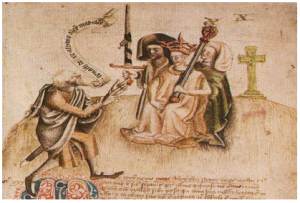On October 6th, 2015, the Centre welcomed Professor Dauvit Broun to discuss ‘Ireland and the beginnings of Scotland’. Below is this listener’s brief summary of the lecture.
Dauvit’s talk focused on the beginning and development of the kingdom and country of Scotland, not only as a political entity, but as a shared experience of its inhabitants at that time. This concept of a single people and country that shared the same laws and customs surfaced in the late twelfth and thirteenth centuries as a culmination of old ideas and assumptions of Scottish kingship, including the idea that the Scots and Irish were linked by a common origin, especially through the Irish descent of the kings of Scots.
Dauvit explained that the concept of ‘a kingdom of jurisdiction’ was a result of a shift from a geographical focus of the kingdom as a landmass to the north of the River Forth and the Firth of Forth, to the idea that the king represented a secular, legal authority for the people. The first specific mention of this in reference to Scotland was in the treaty of Perth in 1266, when Alexander III king of Scots received rights to the kingdom of Mann and the Isles from Magnús VI of Norway:
‘all the men of the said islands … as well lesser as greater, shall be subject to the laws and customs of the kingdom of Scotland and be judged and dealt with according to them from now on.’
Dauvit also demonstrated how these ties to Ireland were addressed by historians during this time period. A narrative which was likely written in the 1260s by Richard Vairement, chancellor of Alexander II’s second queen, available through Fordun’s Chronica Gentis Scottorum, centered around two notions: that Ireland was the divinely ordained homeland of the Scots (not Scotland), and that the original Scottish kingdom was located north of the Forth. The Irish component of this likely comes from the genealogy of the king of Scots, which, although they were often reworked, included Cinead mac Ailpín, the kings of Dál Riata and Fergus Mór son of Erc, and the kings of Ireland in variable order. This appears to be how kingship came to be identified with descent from Ireland, and the later development of the ‘kingdom of jurisdiction’ led to the royal genealogy to be applied to all of the people of the Scotland.
Summary by Megan Kasten (PhD Researcher)
Our seminar series continues on 13 October 2015 with Rachel Barrowman (Ness) discussing ‘Thinking local on the late medieval stronghold of Dùn Èistean, Isle of Lewis’. This will be held in Room 202, 3 University Gardens at 5.30pm.


